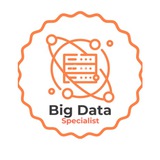tg-me.com/datascience_bds/766
Last Update:
SNOWFLAKES AND DATABRICKS
Snowflake and Databricks are leading cloud data platforms, but how do you choose the right one for your needs?
🌐 𝐒𝐧𝐨𝐰𝐟𝐥𝐚𝐤𝐞
❄️ 𝐍𝐚𝐭𝐮𝐫𝐞: Snowflake operates as a cloud-native data warehouse-as-a-service, streamlining data storage and management without the need for complex infrastructure setup.
❄️ 𝐒𝐭𝐫𝐞𝐧𝐠𝐭𝐡𝐬: It provides robust ELT (Extract, Load, Transform) capabilities primarily through its COPY command, enabling efficient data loading.
❄️ Snowflake offers dedicated schema and file object definitions, enhancing data organization and accessibility.
❄️ 𝐅𝐥𝐞𝐱𝐢𝐛𝐢𝐥𝐢𝐭𝐲: One of its standout features is the ability to create multiple independent compute clusters that can operate on a single data copy. This flexibility allows for enhanced resource allocation based on varying workloads.
❄️ 𝐃𝐚𝐭𝐚 𝐄𝐧𝐠𝐢𝐧𝐞𝐞𝐫𝐢𝐧𝐠: While Snowflake primarily adopts an ELT approach, it seamlessly integrates with popular third-party ETL tools such as Fivetran, Talend, and supports DBT installation. This integration makes it a versatile choice for organizations looking to leverage existing tools.
🌐 𝐃𝐚𝐭𝐚𝐛𝐫𝐢𝐜𝐤𝐬
❄️ 𝐂𝐨𝐫𝐞: Databricks is fundamentally built around processing power, with native support for Apache Spark, making it an exceptional platform for ETL tasks. This integration allows users to perform complex data transformations efficiently.
❄️ 𝐒𝐭𝐨𝐫𝐚𝐠𝐞: It utilizes a 'data lakehouse' architecture, which combines the features of a data lake with the ability to run SQL queries. This model is gaining traction as organizations seek to leverage both structured and unstructured data in a unified framework.
🌐 𝐊𝐞𝐲 𝐓𝐚𝐤𝐞𝐚𝐰𝐚𝐲𝐬
❄️ 𝐃𝐢𝐬𝐭𝐢𝐧𝐜𝐭 𝐍𝐞𝐞𝐝𝐬: Both Snowflake and Databricks excel in their respective areas, addressing different data management requirements.
❄️ 𝐒𝐧𝐨𝐰𝐟𝐥𝐚𝐤𝐞’𝐬 𝐈𝐝𝐞𝐚𝐥 𝐔𝐬𝐞 𝐂𝐚𝐬𝐞: If you are equipped with established ETL tools like Fivetran, Talend, or Tibco, Snowflake could be the perfect choice. It efficiently manages the complexities of database infrastructure, including partitioning, scalability, and indexing.
❄️ 𝐃𝐚𝐭𝐚𝐛𝐫𝐢𝐜𝐤𝐬 𝐟𝐨𝐫 𝐂𝐨𝐦𝐩𝐥𝐞𝐱 𝐋𝐚𝐧𝐝𝐬𝐜𝐚𝐩𝐞𝐬: Conversely, if your organization deals with a complex data landscape characterized by unpredictable sources and schemas, Databricks—with its schema-on-read technique—may be more advantageous.
🌐 𝐂𝐨𝐧𝐜𝐥𝐮𝐬𝐢𝐨𝐧:
Ultimately, the decision between Snowflake and Databricks should align with your specific data needs and organizational goals. Both platforms have established their niches, and understanding their strengths will guide you in selecting the right tool for your data strategy.
BY Data science/ML/AI
Warning: Undefined variable $i in /var/www/tg-me/post.php on line 283
Share with your friend now:
tg-me.com/datascience_bds/766
